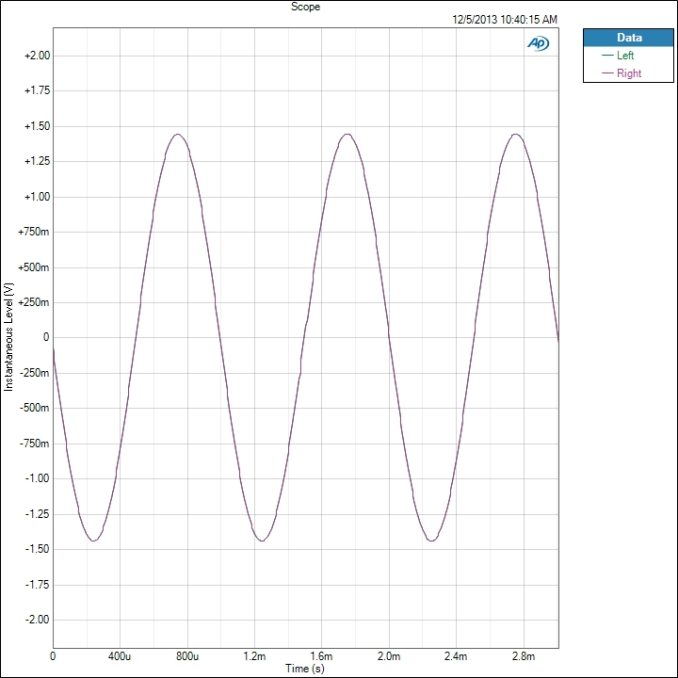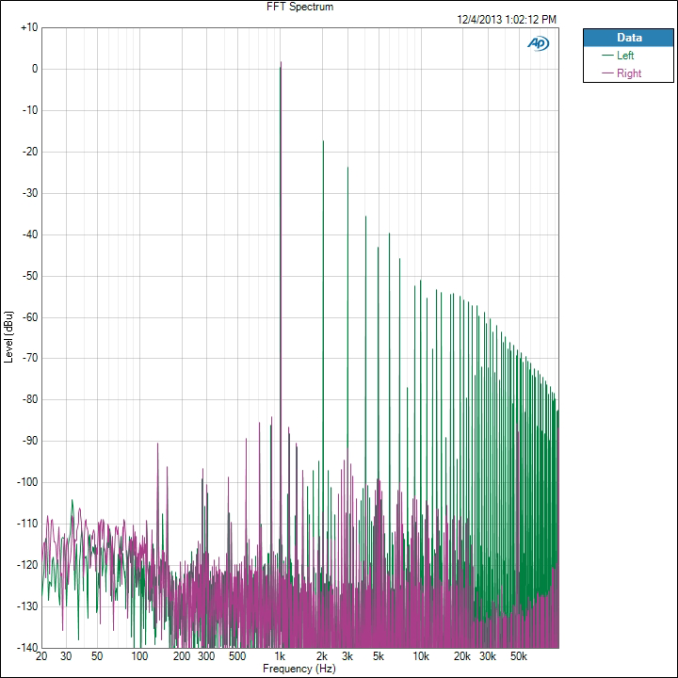Smartphone Audio Quality Testing
by Chris Heinonen on December 8, 2013 5:15 PM EST- Posted in
- Smartphones
- Audio
- Mobile
- Tablets
- Testing
THD+N is a measure of the total harmonic distortion and noise compared to the signal. The lower the number, the less distortion and noise there is relative to the fundamental frequency. THD+N is measured by driving a 1 kHz sine wave at maximum volume. Because there is always some inherent background noise, the THD+N is almost always lowest at maximum output so that is used for the measurement.
There are two results that we take from this: a sine wave and a FFT spectrum. On the sine wave both channels should line up perfectly, and it should be as close to an accurate sine wave as possible. On the FFT we want to see a peak at 1 kHz and everything else as low as possible. The most common artifact you will see are harmonic sidebands at multiples of 1 kHz.
For an example of data that looks good, here is the sine wave of the iPhone 5. We see a sine wave that is good, with channels that overlap perfectly and no deviation. This is what we expect to see.
Now for a different example we look at the Nexus 5. Run at maximum volume we see that the left channel is clipping in the sine wave. Likely the power to the headphone amplifier is not enough to drive both channels and so this is the result. UPDATE: Tested this with 4.4.1 and no change.
The iPhone 5 produces a THD+N ratio of 0.003134% while because of the clipping, the Nexus 5 is producing 13.789197%. Any level over 1% is considered to be past the clipping point of an amplifier and it seems that the Nexus 5 cannot be driven at maximum volume. I tested two samples to verify, and on both the performance is identical.
Now if we look at the FFT for this test, we see how this distortion is showing up. First, the iPhone 5 is very quiet.
There is a 2 kHz peak that is -93 dB below the fundamental frequency, and the 3rd harmonic at 3 kHz is over -109 dB below it. All the harmonics past that are at -120 dB below the fundamental tone. There is some noise out at 50 kHz but this is so far past the level of human hearing that it is safely ignored. Now the Nexus 5 FFT.
We see the right channel, which didn’t clip, looks good. The 2nd harmonic is -111 dB and the 3rd harmonic is -93 dB. On the left channel the 2nd harmonic is only -18 dB and the 3rd harmonic is -24 dB. Even at the 9th harmonic we are still only -52 dB below the fundamental tone. This is causing these incredibly high THD+N numbers that we are seeing on the Nexus 5. We will see more detail of this on a later test as well.
We also chart THD+N vs. Frequency. Here is the chart for the Note 3.
We see that THD+N is basically right below 0.08% for the whole spectrum. It moves up and down slightly, but is very constant. Now here is that Nexus 5 data.
We see that the right channel is around 0.01% THD+N while the left channel, the clipped one, is over 3%. If we ran the Nexus 5 at a lower volume level we would see totally different results, as you’ll find out later, but this is how devices are typically measured.
















188 Comments
View All Comments
cheinonen - Monday, December 9, 2013 - link
No, for the initial set I used basic Apple earbuds that everyone has. I do have AKG K701s to test them on as well, and plan to do so going forward.charltonv3x - Sunday, December 8, 2013 - link
Curious how the test result gonna be for XPERIA Z, ZU, and Z1 against Lumias :)and...can it be used to test ASUS Xonar Vs Onkyo soundcards or other audiophile soundcards...
cheinonen - Monday, December 9, 2013 - link
It can test anything. I use it to test Blu-ray players, preamps, amps, receivers and more. The report it spit out for a receiver for me today was well over 150 pages.Impulses - Monday, December 9, 2013 - link
Testing some other gear might be interesting context wise... i.e. How does a smartphone compare to a Xonar DGX or STX, or to some of the cheaper amps out there (O2? Magni?). Adding stuff like the venerable SanDisk Clip Zip might be even more relevant as far as comparisons go, since that's a great $30 solution for anyone with a phone with disappointing audio.lookit77 - Wednesday, December 11, 2013 - link
+1 for using the SanDisk Clip Zip as one of the benchmarks.mrnuxi - Wednesday, December 11, 2013 - link
Even better than a SanDisk Clip Zip is the older SanDisk Sansa Clip+, which can be found quite cheaply. Here's what will give you a fantastic audio experience:1. Add a 32gb microSDHC card to the Clip Plus with your music encoded as flac (the Clip+ supports flac [lossless] playback.
2. Install the excellent RockBox (http://rockbox.org) replacement firmware.
3. Add the superb FiiO E6 headphone amp. Note: beware of counterfeits on eBay!
4. Use decent or better headphones (at work I use Grado SR60; cycling I use various good quality earbuds).
5. Enjoy your music as you've never heard it on a phone or iPod.
Morgifier - Sunday, December 8, 2013 - link
This is great information, thanks!I have a Nexus 5 and when I plug headphones in I usually listen to level 6 or 7 (out of 15) and have found the audio quality to be to my liking (vs. my old Samsung Galaxy S2).
However, typically when I listen to mobile devices via an amplifier I would turn the device up to MAX volume and then modulate volume via the amp - this does not seem to be the best case for the Nexus 5, I guess stop 12 would be the best volume.
Is amplifier clipping a common occurrence for mobile devices? I consider this a design flaw, i.e. max volume available for the device should be prior to any clipping.
ruzveh - Monday, December 9, 2013 - link
To be honest i have heard many smartphones through one of the best earphones and headphones i dint like the sound quality from any of the smartphones that i have heard compared to the ones that my mp3 players deliver. This is where i hate my smartphone and still love my media players.Can mobile companies take a note on this?
ruzveh - Monday, December 9, 2013 - link
And the fun is we dont get quality DAC for the premium we pay for these phonesshaolin95 - Monday, December 9, 2013 - link
I hope we get to see how the Xperia Z Ultra performs even though I have not seen a review for the phone itself so I guess not much of a change there :/